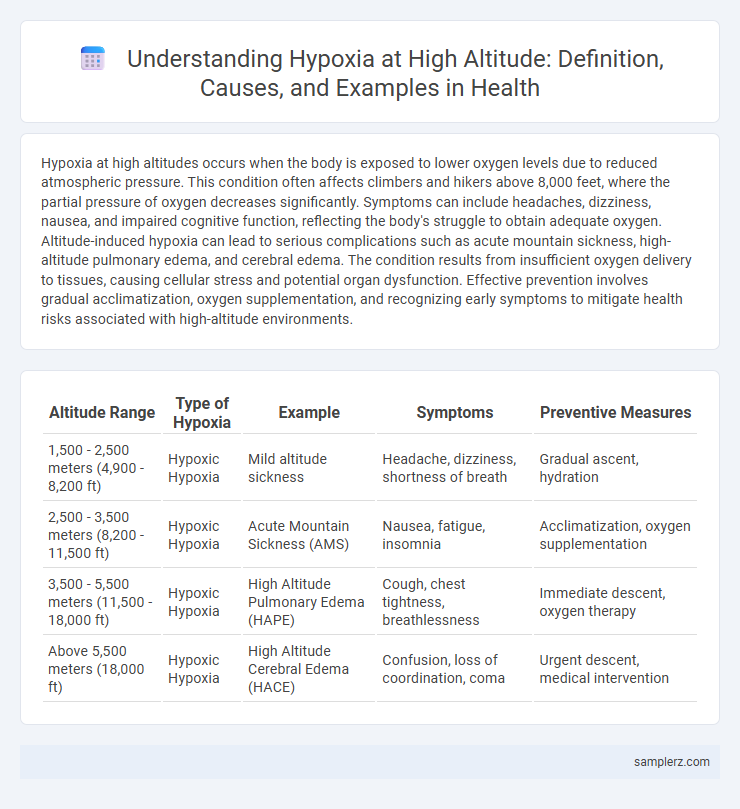Hypoxia at high altitudes occurs when the body is exposed to lower oxygen levels due to reduced atmospheric pressure. This condition often affects climbers and hikers above 8,000 feet, where the partial pressure of oxygen decreases significantly. Symptoms can include headaches, dizziness, nausea, and impaired cognitive function, reflecting the body's struggle to obtain adequate oxygen. Altitude-induced hypoxia can lead to serious complications such as acute mountain sickness, high-altitude pulmonary edema, and cerebral edema. The condition results from insufficient oxygen delivery to tissues, causing cellular stress and potential organ dysfunction. Effective prevention involves gradual acclimatization, oxygen supplementation, and recognizing early symptoms to mitigate health risks associated with high-altitude environments.
Table of Comparison
| Altitude Range | Type of Hypoxia | Example | Symptoms | Preventive Measures |
|---|---|---|---|---|
| 1,500 - 2,500 meters (4,900 - 8,200 ft) | Hypoxic Hypoxia | Mild altitude sickness | Headache, dizziness, shortness of breath | Gradual ascent, hydration |
| 2,500 - 3,500 meters (8,200 - 11,500 ft) | Hypoxic Hypoxia | Acute Mountain Sickness (AMS) | Nausea, fatigue, insomnia | Acclimatization, oxygen supplementation |
| 3,500 - 5,500 meters (11,500 - 18,000 ft) | Hypoxic Hypoxia | High Altitude Pulmonary Edema (HAPE) | Cough, chest tightness, breathlessness | Immediate descent, oxygen therapy |
| Above 5,500 meters (18,000 ft) | Hypoxic Hypoxia | High Altitude Cerebral Edema (HACE) | Confusion, loss of coordination, coma | Urgent descent, medical intervention |
Understanding Hypoxia: Definition and Causes at High Altitudes
Hypoxia at high altitudes occurs due to reduced atmospheric pressure, leading to decreased oxygen availability in the air. This condition is commonly observed in mountaineers and high-altitude trekkers who experience symptoms like shortness of breath, headache, and fatigue. Understanding the physiological impact of hypoxia is crucial for preventing altitude sickness and ensuring proper acclimatization strategies.
Types of Hypoxia Experienced in Mountain Environments
Mountain environments commonly induce hypoxic conditions, with hypoxic hypoxia being the most prevalent due to reduced oxygen availability at high altitudes. Hypemic hypoxia may occur in climbers with anemia or carbon monoxide exposure, impairing oxygen transport in the blood. Stagnant hypoxia can result from poor circulation caused by cold or dehydration, limiting oxygen delivery to tissues despite adequate oxygen levels in the lungs.
Common Symptoms of Altitude-Induced Hypoxia
Altitude-induced hypoxia commonly presents with symptoms such as headache, dizziness, and shortness of breath. Other frequent signs include fatigue, nausea, and impaired cognitive function due to reduced oxygen availability at high elevations. Early recognition of these symptoms is crucial for preventing severe complications like high-altitude pulmonary edema or cerebral edema.
Real-Life Examples: Hypoxia in Mount Everest Climbers
Mount Everest climbers experience hypoxia due to drastically reduced oxygen levels at altitudes above 8,000 meters, where atmospheric oxygen pressure is about one-third of sea level. Symptoms such as confusion, impaired coordination, and extreme fatigue are common, often leading to high-altitude cerebral edema (HACE) or high-altitude pulmonary edema (HAPE). Supplemental oxygen and acclimatization strategies are critical to prevent severe hypoxic effects and ensure climbers' survival in these extreme conditions.
Case Study: High-Altitude Hypoxia in Pilots and Aircrews
High-altitude hypoxia significantly impairs cognitive and physical performance in pilots and aircrews, as shown in case studies conducted at elevations above 10,000 feet where oxygen partial pressure decreases sharply. Symptoms such as dizziness, impaired judgment, and decreased reaction times have been documented, highlighting the critical need for supplemental oxygen systems and rigorous altitude training protocols. Research emphasizes that timely recognition and management of hypoxia are essential to maintaining flight safety and operational effectiveness in aviation environments.
Hypoxia in Recreational Hikers: Warning Signs and Risks
Hypoxia in recreational hikers at high altitude commonly manifests as headaches, dizziness, and shortness of breath due to decreased oxygen availability above 8,000 feet. Acute Mountain Sickness (AMS) can progress to more serious conditions such as High Altitude Pulmonary Edema (HAPE) or High Altitude Cerebral Edema (HACE), increasing risk for fatal outcomes if untreated. Recognizing early warning signs like nausea, fatigue, and impaired coordination is crucial for prompt descent and oxygen therapy to prevent severe hypoxic injury.
Adaptation Mechanisms: How the Body Responds to Altitude Hypoxia
At high altitudes, the body adapts to hypoxia through increased ventilation, enhancing oxygen intake and carbon dioxide expulsion. Erythropoiesis is stimulated, raising red blood cell count and hemoglobin concentration to improve oxygen transport in the bloodstream. Additionally, cellular adaptations improve mitochondrial efficiency and oxygen utilization, supporting metabolic demands despite reduced atmospheric oxygen.
Preventive Measures to Avoid Hypoxia While Climbing
Climbers should ascend gradually to allow acclimatization and reduce the risk of hypoxia at high altitudes above 8,000 feet. Using supplemental oxygen and monitoring oxygen saturation with pulse oximeters are essential preventive measures to maintain safe oxygen levels. Staying hydrated, avoiding overexertion, and recognizing early symptoms like headache or dizziness can help prevent severe altitude sickness during mountain expeditions.
Emergency Treatments for Altitude-Related Hypoxia
Emergency treatments for altitude-related hypoxia include immediate descent to lower altitudes, administration of supplemental oxygen, and the use of portable hyperbaric chambers to simulate sea-level pressure. Medical interventions such as corticosteroids and acetazolamide can reduce symptoms and improve oxygenation. Rapid recognition and treatment of hypoxia are critical to prevent high-altitude pulmonary edema (HAPE) and high-altitude cerebral edema (HACE), which require urgent medical care.
Long-Term Health Effects of Repeated Altitude Hypoxia
Repeated altitude hypoxia, experienced during prolonged exposure to high altitudes, can lead to chronic mountain sickness characterized by excessive red blood cell production and increased blood viscosity. This condition raises the risk of pulmonary hypertension and right heart failure, significantly impacting cardiovascular health. Long-term hypoxic stress also contributes to cognitive decline and impaired physical performance due to sustained oxygen deprivation in brain tissues.

example of hypoxia in altitude Infographic
 samplerz.com
samplerz.com